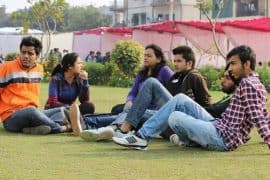A breakdown of the Aarey Forest conservation movement of Mumbai, in light of the current global climate crisis.
The Aarey Colony protests began on 5th October 2019, after the Bombay High Court (HC) allowed the Mumbai Metro to
cut nearly 2,500 trees to build a car shed for the new Mumbai Metro constructions in the vicinity. The HC’s move was in line with
a fine technicality that the Aarey Forest was not really a forest after all, but it was merely an urban cluster and hence it could
be felled for the purpose of establishing the Metro infrastructure. This move was met with severe backlash, as Mumbaikars
and green activists around the country opposed the felling of 2,500 trees that gave the much-needed respite from pollution
and heat to the residents of the colony.
The Mumbai Metro Rail Corporation Limited (MMRCL) began to cut down trees in the area merely hours after the HC order, at odd hours of night in another move that faced resistance from citizens and environmental activists. The Mumbai police arrested close to 29 people on the charges of allegedly obstructing and assaulting police personnel at this protest. Many people, including several celebrities, took to social media to express their support with the activists protesting in the Aarey Colony. After these events, a special hearing on the matter was scheduled with the Supreme Court (SC) and, as a result, Section 144 of the Indian Penal Code (IPC) was implemented in Aarey Colony. Although lifted for the hearing, the section was later reimposed after the hearing.
The Apex Court, this past week, restrained authorities from cutting any more trees in Mumbai’s Aarey. A special bench comprising Justices Arun Mishra and Ashok Bhushan said that it would have to examine the entire matter closely, and it extended the date of the next hearing to 21st October, which would take place before its forest bench. The court also ordered the Mumbai Police to release all the activists who were arrested in the past two days.
The SC recorded an undertaking by the Maharashtra State Government, where it was assured that no more trees would be felled in Aarey. The SC observed that “…it appears that Aarey was some kind of forest at some time,” taking note of the 2012 Management Plan for the Sanjay Gandhi National Park, which describes Aarey as an unclassified forest.
The Court further lashed at the Maharashtra State Government, “Tell us how many saplings you planted? How have they grown? What’s the status of your forests?” The Apex Court’s question came after the Mumbai Metro claimed that it had planted around 24,000 saplings to replace the trees it had cut in Aarey. The court asked the state authorities to also produce a mandatory afforestation report.
Rishav Ranjan — the law student whose letter to the Chief Justice of India, Ranjan Gogoi, was converted into a suo motu writ petition for the matter — has requested MMRCL Managing Director, Ashwini Bhide, to desist from any construction work in the area until the next SC hearing on 21st October.
Complex climate change situations necessitate nuanced interventions. However, for the most part, India has resorted to afforestation without consulting local communities or conducting serious impact assessment studies. In light of the latest global climate crisis, a Global Climate Risk Index released at the Katowice summit in Katowice, Poland, in 2018 showed that intense cyclones, excessive rainfall, and severe floods could make India and its neighbours among the worst affected countries in the world. This leads to the conclusion that afforestation is not enough. The
effects of climate change in tandem with the development agenda require a two-pronged, well-researched, and balanced
approach that needs to be initiated by the governments at grass-root levels.
Featured Image Credits: India Times
Bhavya Pandey
[email protected]




Comments are closed.